Best ASUS ZenBooks for Video Editing & Creative Work
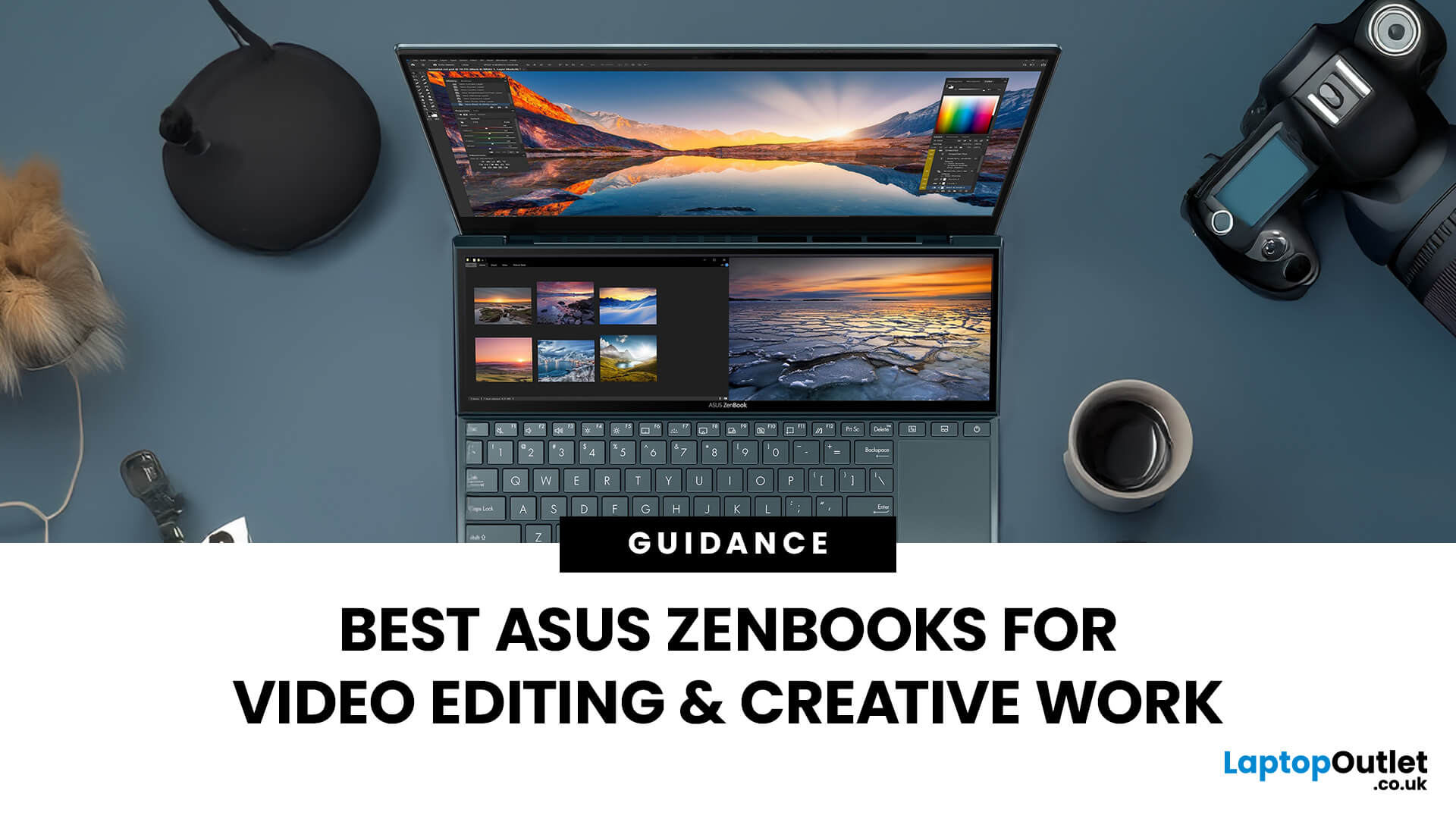
In the world of video editing, motion graphics and creative workflows, picking the right laptop isn’t just about getting “something that works” - it’s about securing a machine that gives you freedom, performance and accuracy. If you’re a professional creator in the UK (or serve the retail/B2C market), you’ll want something that doesn’t compromise when you’re rendering timelines, colour‐grading in 10-bit, switching between apps, or hauling your work between studio and location. That’s where the ASUS ZenBook line comes in.
Why ASUS ZenBooks Are Ideal for Video Editing & Creative Work
The ZenBook range has carved out a strong position for creators, offering a blend of build quality, lightweight design, powerful internals and premium displays. According to ASUS, their “creator” ZenBooks are designed specifically for editing, design and graphics-intensive workflows.
Here are some of the key features that make them stand out:
- Display quality: Many ZenBooks offer OLED panels, high refresh rates, wide colour gamut (100 % DCI-P3) and excellent contrast - all vital when you’re colour grading or previewing HDR footage. For example, one model boasts a 4K OLED with 100% DCI-P3 coverage and 0.2 ms response time.
- High-end hardware: For video editing and rendering you’ll want plenty of cores, dedicated GPU and fast SSDs. ZenBooks increasingly deliver with Core-i9/Ultra, Nvidia RTX or Intel Arc graphics, high-capacity RAM and PCIe 4.0/PCIe 5.0 storage.
- Portability and design: Many creator machines are heavy and bulky, but ZenBooks aim to offer slimmer, lighter chassis - which matters when you’re on location or moving between studios.
- Creator-friendly tools: Some models include ScreenPad, dual-screen layouts, ASUS Dial or other workflow enhancements - useful for editors who need multi-tasking overlays, timeline review panels, scripting windows etc.
- Creator-centric branding: ASUS lists ZenBook under its “Laptops for Creators” section, emphasising they’re built with video/photo editing, design and animation in mind.
In short: if you’re editing 4K/8K video, grading colour, juggling multiple creative apps, a ZenBook is more likely to keep up than a standard consumer Ultrabook.
Key Factors to Consider Before Buying a ZenBook for Editing
Before we dive into the 7 best models, it’s worth pausing to consider thekey hardware and workflow elementsyou should evaluate when choosing a laptop for creative work. For professional editors and designers, the difference is real.
|
Spec |
Why it matters |
|
CPU (cores/threads + clock speed) |
Editing and rendering (e.g., in Adobe Premiere Pro, DaVinci Resolve) benefit from many cores/threads. The faster the clock speed, the better for timeline responsiveness. |
|
GPU / Dedicated graphics |
Video effects, accelerated exports, colour grading filters often use GPU. Having an Nvidia RTX or Intel Arc is a major plus. |
|
Display quality (resolution, panel type, colour gamut) |
For colour-critical work you’ll want wide gamut (100% DCI-P3 or AdobeRGB), accurate colour calibration, and preferably OLED or high-end IPS. |
|
RAM & Storage (SSD) |
For editing large footage you’ll want at least 32 GB RAM (often 64 GB or more for 4K/8K workflows), and a fast high-capacity SSD (1 TB+). |
|
Thermals & build/portability |
High-performance hardware generates heat. You’ll want a laptop that manages thermals without throttling, while still being portable enough for your workflow. |
|
Connectivity & I/O |
SD card reader, Thunderbolt/USB-C, HDMI, multiple ports matter when you’re connecting monitors, eGPUs, external drives, control surfaces. |
|
Display size & portability trade-off |
A 17″ display may be ideal for timeline/spaces, but a 14–15″ model may be much easier to carry. Balance weight vs screen size. |
So, when you see references like “ZenBook with OLED display for editing” or “ZenBook with high RAM and SSD”, these are exactly the sorts of features that separate an average laptop from one built for creators.
The 7 Best ASUS ZenBooks for Video Editing & Creative Work (2025 Edition)
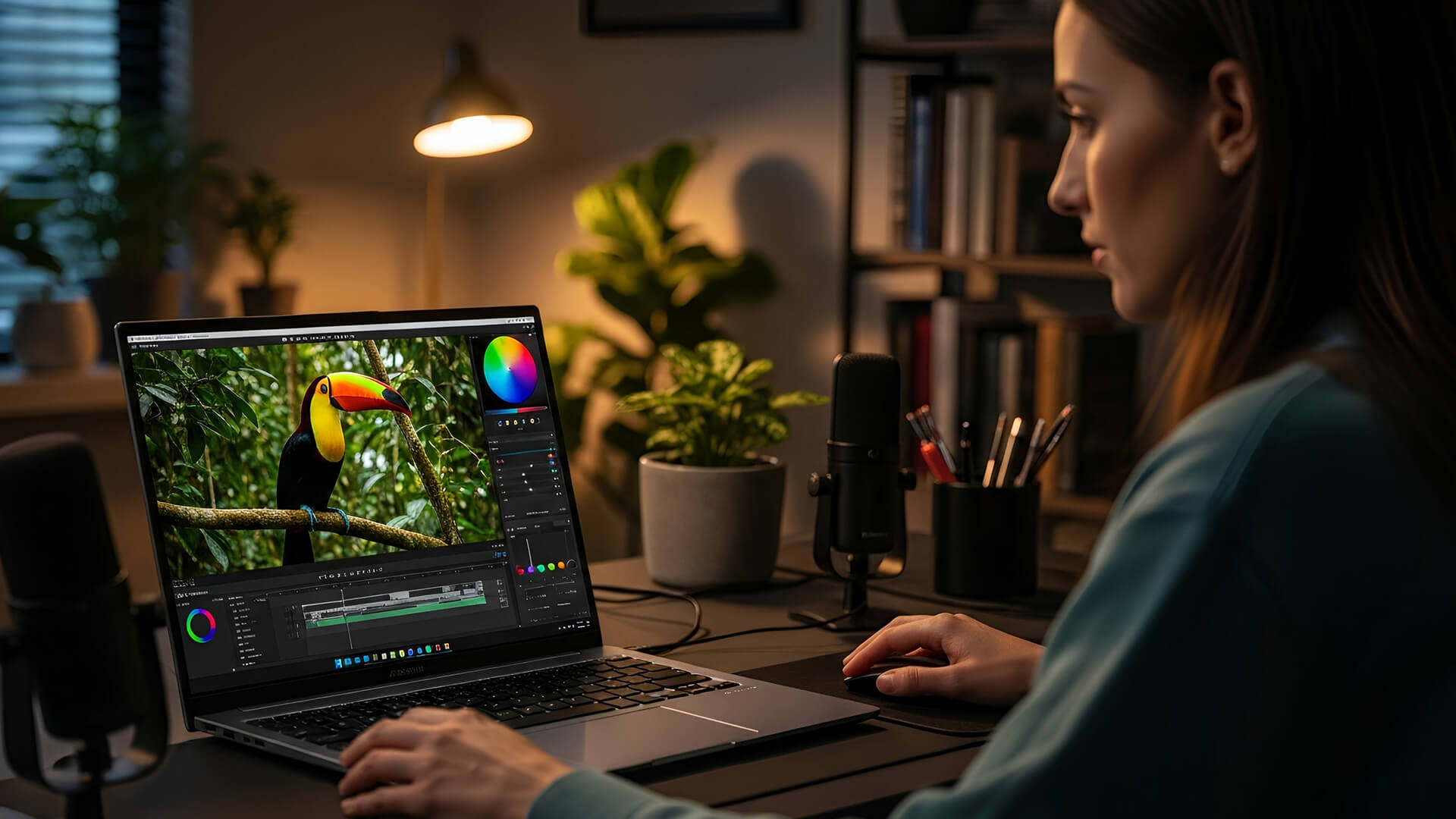
Below are seven standout ZenBook models tailored for creative professionals. Each is chosen for a specific strength - whether ultimate power, portability, dual-screen flexibility or best value.
1. ASUS ZenBook Pro Duo 16 OLED (UX7602)
This is the top-tier machine for serious video editing and rendering workflows. It blends a large 16″ OLED main display with dual-screen capabilities, high core count CPUs and dedicated GPU power. For example, one version of the earlier UX581 offered a 15.6″ 4K OLED (100% DCI-P3) plus a ScreenPad Plus secondary display.
Why it stands out:
- Huge screen real estate for timeline and scopes.
- Secondary ScreenPad or second display helps put control panels, metadata, proxies off the main screen.
- Dedicated GPU (e.g., RTX) for accelerating effects/export.
- Ideal for full-blown editing suites.
Considerations:
- Bigger size and weight - less portable.
- Likely higher price point in the UK.
- Battery life will naturally be lower under heavy load.
2. ASUS ZenBook Pro 14 OLED (UX6404)
A more compact powerhouse. According to ASUS this 14.5″ model packs up to a 13th-Gen Intel Core i9 and NVIDIA GeForce RTX 4070 GPU in an ultra-compact chassis.
Why it stands out:
- Exceptional power for size - great for editors who value portability.
- High-end display (OLED) and GPU combination gives real creative-grade performance.
- Less bulk, easier to travel with.
Considerations:
- Smaller screen size than 16–17″ models - may feel a bit tight for timeline work.
- May sacrifice a little thermal headroom due to compact chassis.
3. ASUS ZenBook Duo 14 OLED (UX8406)
For multitaskers and creative professionals who really benefit from dual-screen layouts, this is a compelling pick. The 2024/2025 UX8406 features dual 14″ OLED touchscreens, up to Intel Core Ultra 9, Intel Arc graphics, and a 120Hz refresh rate display.
Why it stands out:
- Dual screen means your edit timeline and preview can sit on separate screens, or you can keep media / tools visible while you work.
- Ideal for colour grading while editing, motion graphics workflows, or those who juggle apps.
- Unique form factor that sets it apart for creative workflows.
Considerations:
- More expensive than standard single-screen models.
- Battery life and thermal behaviour may vary because of dual displays.
- Learning curve: dual-screen layout works well if workflow adapts to it.
4. ASUS ZenBook 14 Creator OLED
A solid mid-range creator machine that balances performance and value. As per Amazon listing: 14″ OLED touch display (100% DCI-P3), Intel 16-core Ultra 7 255H, 16 GB RAM / 512 GB SSD.
Why it stands out:
- Good fit for creators who don’t need the absolute top specs but still need serious performance.
- Great display for colour work, decent portability.
- More affordable entry point into creator-grade laptops.
Considerations:
- 16 GB RAM may be a limitation for heavy 4K/8K workflows - upgrading to 32 GB or more is advisable when possible.
- Dedicated GPU may be weaker or integrated in some variants - check configuration.
5. ASUS ZenBook S 16 OLED
This model was highlighted by TechRadar as one of the best ultrabooks in 2025, featuring a 16″ 3K OLED (120Hz), AMD Ryzen AI 9 HX 370, Radeon 890M graphics, 32 GB RAM, dual-purpose design.
Why it stands out:
- Larger 16″ display in a relatively thin form factor, great for creator work without bulk.
- Excellent display and spec combination for professional workloads.
- Ideal if you want something powerful yet reasonably portable.
Considerations:
- No massive dedicated “desktop-style” GPU maybe; may not match the full power of 3080/4080 class models for very heavy effects/rendering.
- Battery life is still a trade-off at high load.
6. ASUS ZenBook 15 OLED
A more traditional size - 15″ class offering a good blend of screen size, performance and value. ASUS lists ZenBook 15 OLED under creators.
Why it stands out:
- Balanced size: larger than 14″ but still portable.
- Good for reviewers/creators who want a full-sized screen for timeline and framing but still want mobility.
- Likely to come at a more accessible price point than ultra-premium 16–17″.
Considerations:
- Ensure you pick a configuration with a dedicated GPU and good cooling if you will do serious video editing.
- Check display quality (100% DCI-P3 etc) for colour-critical work.
7. ASUS ZenBook Pro 16X OLED
For the uncompromising professional editor, 3D creator or motion graphics studio person, this is the top-end machine. While specific model specs may vary, ASUS has offered 16″ Pro models with Core Ultra, RTX 4080, OLED colour-grade displays.
Why it stands out:
- Ultra-high performance for pro workflows: 3D rendering, 8K editing, heavy effects.
- Big display real estate combined with high-end GPU.
- Futureproofing for creative professionals.
Considerations:
- The price will be significantly higher.
- The bulk and weight will be greater than more portable models.
- Battery life may be limited under full load - but many professionals use these in-studio or plugged in anyway.
Best ZenBook for Adobe Premiere Pro, DaVinci Resolve & After Effects
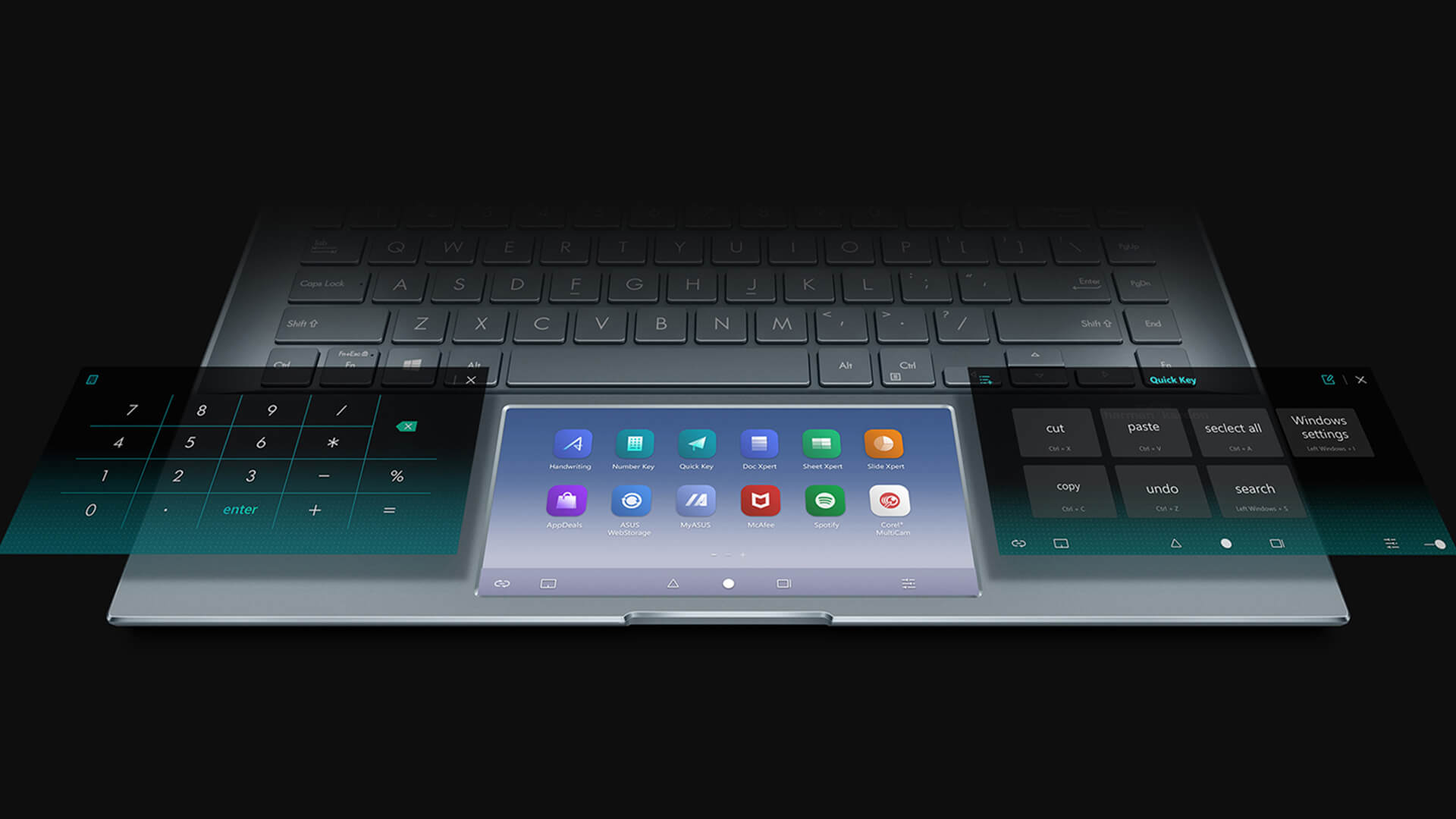
If you use specific software workflows, here are some quick recommendations:
- Adobe Premiere Pro: Good all-round performance with high cores + GPU acceleration. A model like the Pro 16X or Pro Duo is ideal for heavy export.
- DaVinci Resolve: Colour grading and RAW workflows demand strong GPU and display. OLED panels and RTX/Arc GPUs matter; the Duo or Pro Duo lines shine.
- After Effects / Motion Graphics: Often a mix of CPU + GPU + RAM. A compact but powerful machine (Pro 14) may hit the sweet spot for mobility + power.
Look for features like “ZenBook for video editing and rendering”, “ZenBook with dedicated GPU”, and “ZenBook for multitasking and editing” in your spec's checklist.
How ZenBook’s OLED Displays Elevate Editing Quality
One of the biggest differentiators for creators is display quality. A laptop may be fast, but if the screen can’t accurately represent colour, contrast, or HDR, you’ll struggle with grading, previewing or client reviews.
Here are a few highlights of why OLED matters:
- Deep blacks and infinite contrast make it easier to judge colour and lighting in footage.
- Wide colour gamut (100% DCI-P3) ensures what you see is what clients (and output devices) expect. Some models have that 100% DCI-P3 spec.
- Faster response and higher refresh rates (in some models) can make timeline scrubbing and review smoother.
- Many ZenBook creator laptops list features like NanoEdge display, HDR certification and calibration. Eg: the Pro 14 OLED (UX6404) emphasises “studio-grade” display.
So, when you see keywords like “ZenBook with OLED display for editing”, you’re zeroing in on machines built for precision creative work, not just casual browsing.
Choosing Between ZenBook and Other ASUS Creator Laptops

You might ask: why ZenBook and not something else like the ASUS ProArt or ROG Flow series? It’s a valid question.
Here’s a snapshot:
- ZenBook: Balanced for creators - powerful, portable, premium build, creator-friendly.
- ProArt: More studio-grade machines - heavier, more full-blown, often for 3D rendering, high-end workstations.
- ROG / Gaming-oriented: Top GPU power but may compromise on display calibration, professional ports, or portability.
According to CG Director, the difference between ZenBook, Vivobook and ProArt lies in target user, budget and display specs.
If your workflow involves frequent travel or editing on location, ZenBook is a smart choice. If you’re anchored to a studio and doing heavy graphics/3D/large scale rendering, you might consider ProArt. But for creative professionals needing a mix of power + portability + high-quality display, the ZenBook line hits the sweet spot.
Which ZenBook Is Right for You?
Let’s summarise which ZenBook might be the best fit, depending on your needs:
|
Use-case |
Recommended Model |
Why |
|
Ultimate power for studio editing & rendering |
ZenBook Pro 16X OLED |
High-end specs, top GPU, large display |
|
Dual-screen multitasking workflows |
ZenBook Duo 14 OLED |
Two screens = timeline + tools separation |
|
High power but good portability |
ZenBook Pro 14 OLED (UX6404) |
Compact size, serious GPU |
|
Balanced creator laptop under budget |
ZenBook 14 Creator OLED |
Good specs, value option |
|
Large display but light form factor |
ZenBook S 16 OLED |
16″ display in ultrabook chassis |
|
Mid-sized size for mainstream editing |
ZenBook 15 OLED |
15″ size, decent specs |
|
Entry-level creator laptop for lighter workflows |
ZenBook 14 Creator (or 14X) |
Good for video editing, design, lighter render tasks |
If you’re convinced and ready to browse, check out the ASUS ZenBook Series page at Laptop Outlet, or explore their creative laptops section for more models and deals.

FAQs
Can ASUS ZenBooks handle 4K or 8K video editing?
Yes. Models with Intel Core i9/Ultra CPUs, RTX GPUs, and 32 GB RAM+ easily manage 4K/8K workflows.
Why choose an OLED display for editing?
OLED screens deliver true blacks, vivid colours, and 100% DCI-P3 accuracy - ideal for colour-critical work.
Do I need a dedicated GPU for editing?
Yes. A ZenBook with an NVIDIA RTX or Intel Arc GPU ensures smooth rendering and faster exports.
What specs should I look for?
Aim for Intel Core i7 / i9 or Ryzen 9, RTX GPU, 32 GB RAM, 1 TB SSD, and an OLED display.
Are ZenBooks good for travel and studio use?
Absolutely. They balance high-end creative power with lightweight, portable designs perfect for on-the-go editing.

Wrap-up
Choosing the right laptop for creative work is more than just picking the fastest chip or largest SSD. It’s about balance, of processing power, GPU acceleration, display quality, I/O ports, portability and reliability. The ASUS ZenBook line delivers on that balance, particularly for professional video editors, designers and creators in the UK market.
Whether you’re exporting 4K timelines in Premiere Pro, colour grading footage in DaVinci Resolve, creating graphics in After Effects, or producing client-ready videos while on location - there’s a ZenBook ready to match your workflow. With the 7 models listed here, you can match your budget, screen size preference, mobility needs and performance requirements.
Now your next step: evaluate your current editing workflow (footage resolution, software, external monitors, mobility), set your budget, and pick the ZenBook that aligns best with your creative workload. Happy editing - and may your renders finish faster than you expect!
| Read More: |
| Battery Life & Performance Optimisation Tips for ZenBook Users |
| Is Asus ZenBook Better than HP ENVY? Best Asus Laptops |
| Is ASUS ZenBook Good for Students |
Related Articles
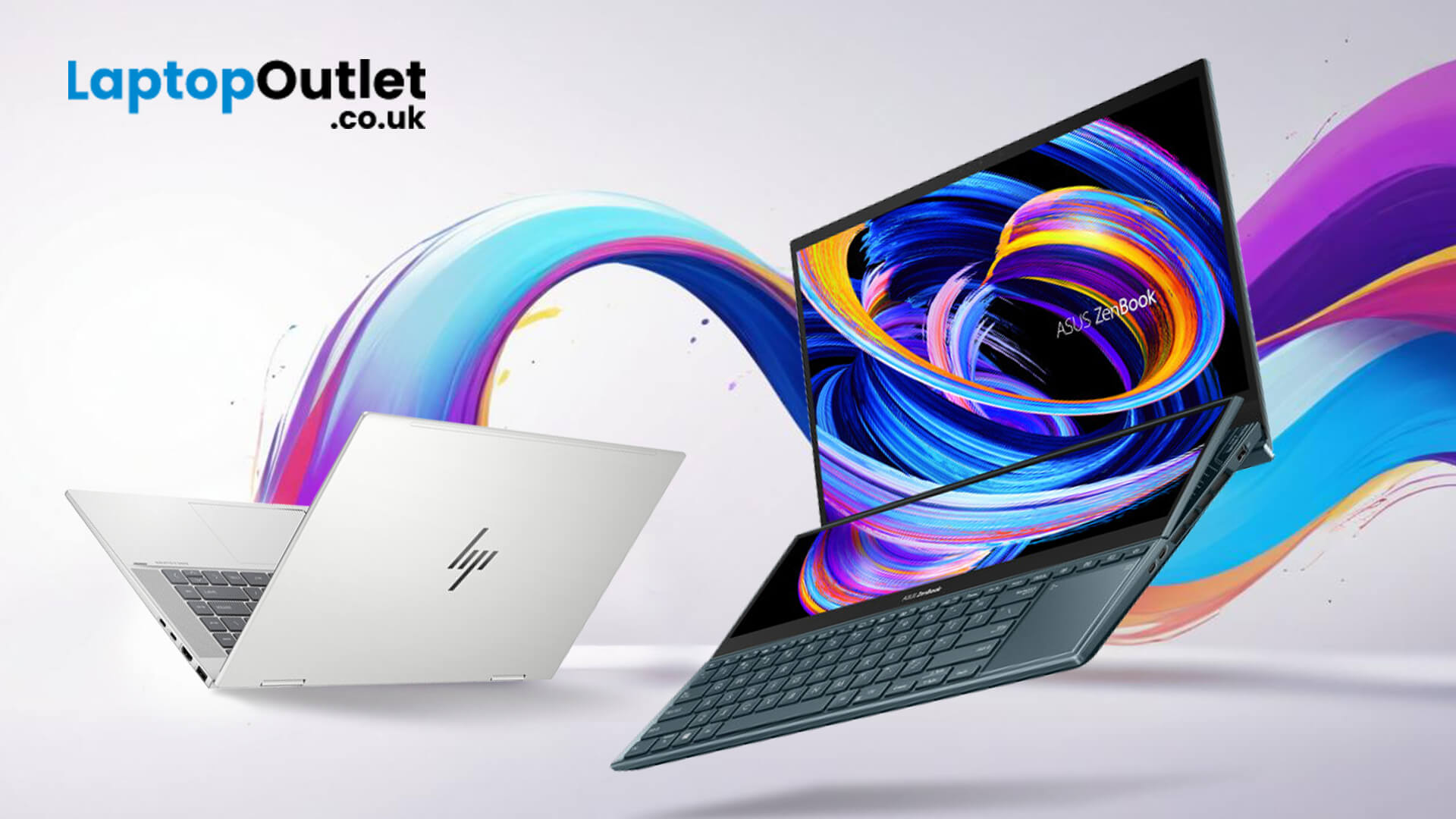
July 24, 2024
Deciding between ASUS and HP laptops can feel like a maze of tech specs and user reviews. Luckily, you are not alone; even as an experienced tech enthusiast, it was quite a puzzle for us to solve. According to reports, these two brands will share nearly 40% of the global laptop market in 2024.
ASUS and HP are known for their durable and high-performance laptops, which are available at various demands and prices. So, what should you choose between them? Let’s discuss this in this blog post!
About ASUS Laptops
As for ASUS laptops, the brand emphasises innovative features to make them a good competitor in the computer industry, like dual screens, backlit keyboard and touchpad, faster CPUs, and various ports. The best ASUS laptops reign for their sleek, innovative design and high-quality hardware. The ASUS ZenBook series proves the brand's commitment to power and innovation. ZenBook models have gorgeous screens, decent battery life, and excellent keyboards. Their
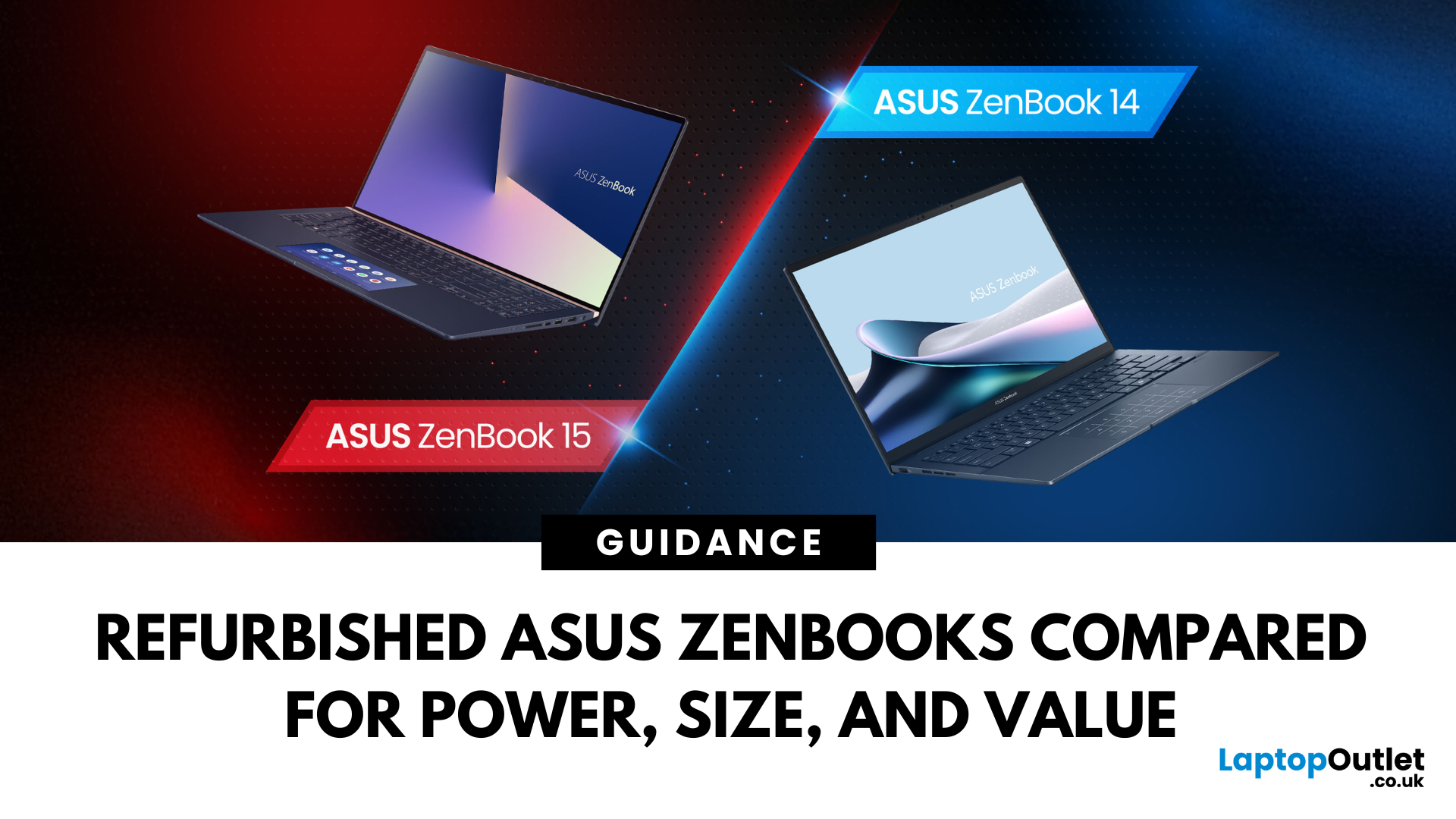
June 26, 2025
Two ZenBooks, One Big Decision
Looking for a slick ASUS ZenBook but stuck between the 14 and 15? Whether you’re a student on the move or a creator chasing peak performance, the refurbished ASUS ZenBook 14 and 15 pack serious punch — without the premium price tag.
In this guide, we break down the key differences in size, specs, and use cases, and help you decide which one’s right for you. Refurbished laptops offer incredible value – and we’re here to help you score the best one for your setup.
Key Differences Between Refurbished ASUS ZenBook 14 and ZenBook 15
While both the ASUS ZenBook 14 and 15 deliver premium performance at unbeatable prices when refurbished, their differences go beyond screen size. If you're choosing between them, it's all about how and where you'll use your laptop — whether you're on the go, creating content, or just want a smooth daily experience.
Portability and Everyday Use
The Refurbished ZenBook 14 OLED is built for mobility. Weighing just around 1.39kg and measuring

July 07, 2025
A Smart Choice for Smarter Study?
Choosing a laptop for school or university? The ASUS ZenBook is often praised for its sleek design and solid specs—but is it really the best laptop for students in 2025? Let’s break down its strengths, weaknesses, and whether it’s right for your academic life.
What Is the ASUS ZenBook?
The ZenBook is ASUS’s premium ultrabook range—lightweight, stylish, and packed with high-performance components. Designed for productivity and mobility, it’s a go-to for professionals, creatives, and yes—students.
Why Students Love the ZenBook
- Lightweight design – easy to carry to lectures or cafes
- Long battery life – up to 10–14 hours depending on model
- Fast processors – Intel Core i5/i7 or AMD Ryzen 5/7
- Full HD or OLED screens – clear visuals for research and video
- Great keyboard & trackpad – for comfortable writing and multitasking
ZenBook Models for Students (2025 Picks)
ZenBook 14 (UX425)
- Ultra-light (1.2kg)
- 11th/12th Gen Intel or Ryzen processors

August 13, 2025
What’s the Main Difference Between ASUS ProArt and ZenBook?
The ASUS ProArt series is engineered for professional content creators working in video production, photography, animation, and 3D modelling. It delivers ISV-certified performance, ultra-accurate colour displays, and AI-powered creator tools like ASUS DialPad and Creator Hub.
The ASUS ZenBook series targets professionals and creatives who need portability, battery endurance, and sleek aesthetics. While still capable for creative work, ZenBooks are tuned for light-to-moderate creative tasks, multitasking, and on-the-go use rather than maximum workstation output.
Specs Face-Off: ASUS ProArt vs ZenBook
|
Feature |
ASUS ProArt Series |
ASUS ZenBook Series |
|
Target Audience |
Professional creators needing maximum power and colour precision |
Mobile creatives, designers, and professionals seeking portability and style |
|
Performance Focus |
Workstation CPUs & NVIDIA RTX GPUs, ISV-certified for Adobe/Autodesk |
Efficient CPUs, integrated or mid-tier GPUs, |
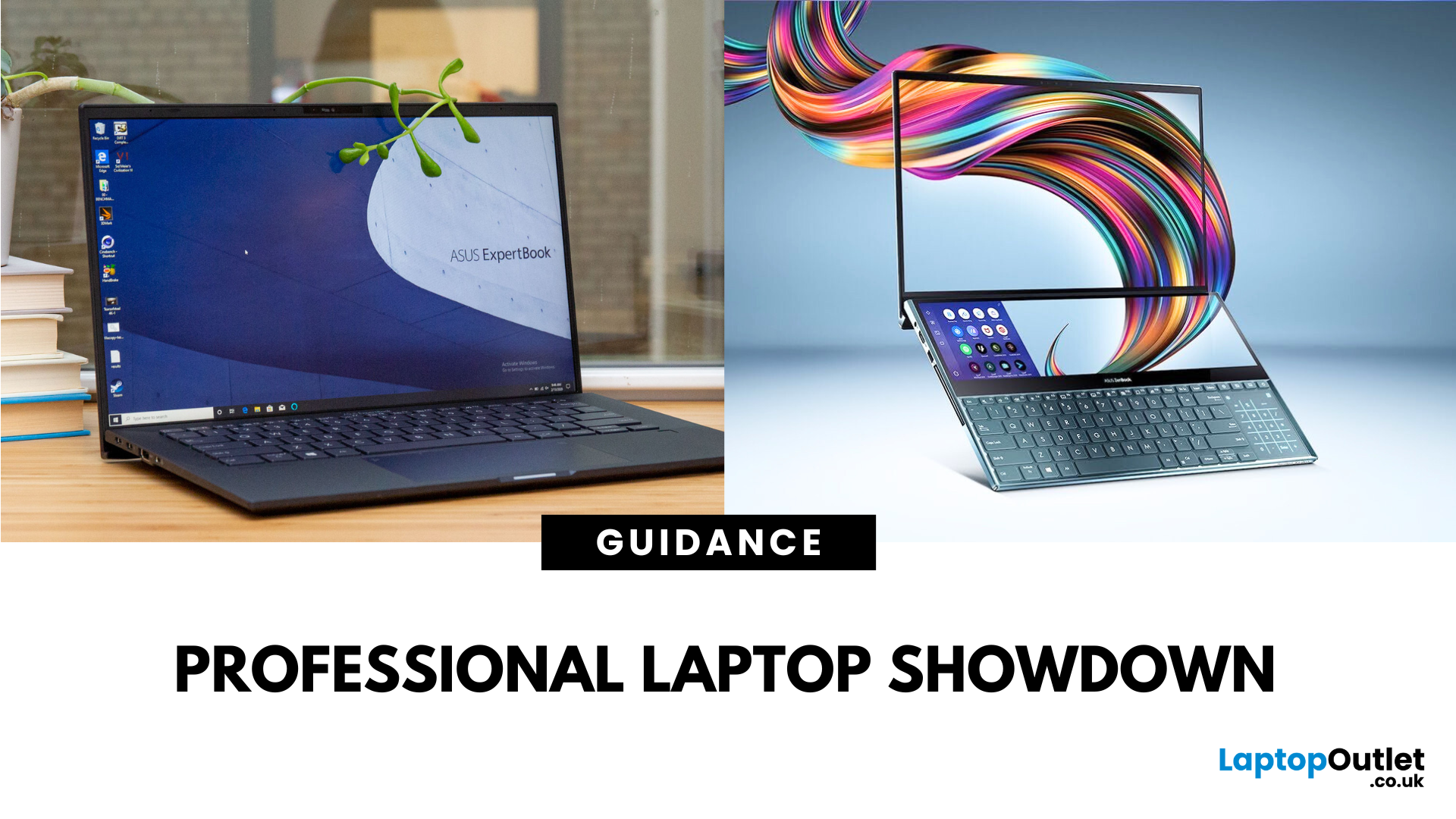
August 13, 2025
What’s the Difference Between ExpertBook and ZenBook?
The ExpertBook line is designed for professionals who demand durability, lightweight builds, enterprise features, and long battery life often with vPro support and MIL-STD testing. The ZenBook series decks out innovators and creators with premium OLED (and even dual-screen) displays, ultra-light designs, and high-end performance geared toward aesthetics and mobility.
Specs Face-Off: ExpertBook vs ZenBook
|
Spec Category |
ExpertBook (e.g., B5, B1, P3) |
ZenBook (e.g., 14 OLED, Duo, S16) |
|
Build & Weight |
Ultra-light (~1.27–1.41 kg), MILSTD durability |
Super-slim (~1.2–1.5 kg), aluminium/titanium builds, dual-screen option |
|
Display & Visuals |
Business-friendly 14" FHD or WQXGA screens, optional touch/stylus |
Stunning 14" 2.8K OLED at 120 Hz, vivid dual-screen Duo models, immersive S16 displays |
|
Performance |
Up to Intel Ultra 7 with vPro, optional Arc/RTX GPU in some models |
Core Ultra 7 or Ryzen AI CPUs, upgraded for creatives and heavy multitasking |

August 15, 2025
What’s the Difference Between VivoBook and ZenBook?
VivoBook is ASUS’s mainstream lineup—affordable, performance-balanced laptops for everyday use, students, and casual users. On the other hand, ZenBook is the premium alternative—sleek, aluminum builds, slim profiles, higher specs, and aimed at professionals or users who want long-term durability and style.
Feature Comparison Table
|
Feature |
VivoBook |
ZenBook |
|
Build & Design |
Plastic/metal mix, budget-friendly |
All-metal, ultra-slim premium build |
|
Performance |
Good everyday CPUs (e.g. Ryzen 5, Intel U-series) |
Higher-end CPUs, often Core Ultra or better |
|
Display |
Reliable FHD panels |
Often OLED or higher-quality touchscreens |
|
Battery Life |
Solid, entry-level (~8–10 h) |
Excellent endurance—up to ~16 h on OLED ZenBook 14 OLED |
|
Portability |
Moderate—lighter options available |
Thinner and lighter overall |
|
Price |
Very budget-friendly |
Premium pricing, but great value for specs |
Performance & Design
- VivoBook: Offers solid specs for
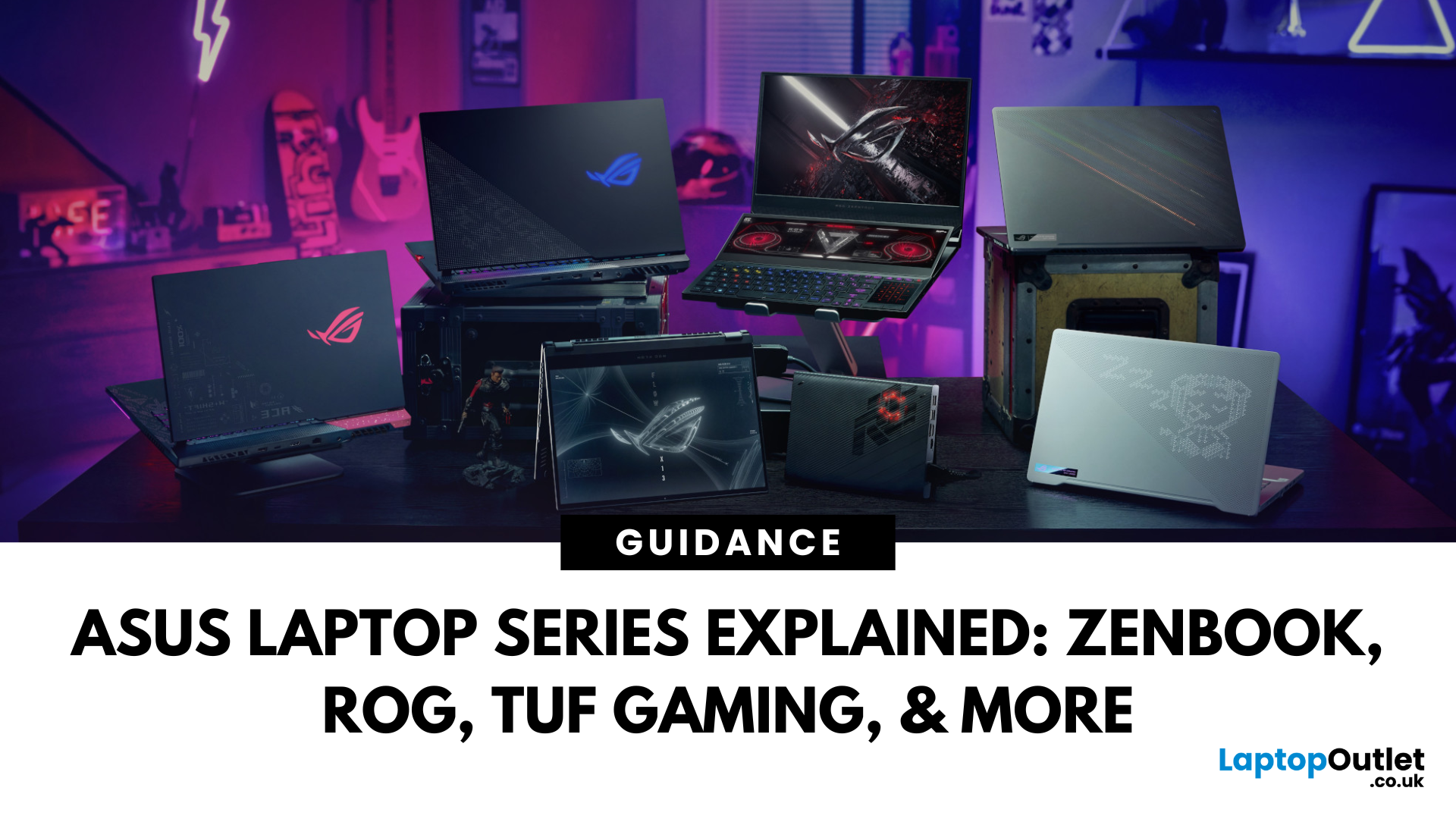
August 29, 2025
Choosing the right laptop in 2025 can feel like a challenge. With endless options in the UK market, different brands, specifications, and price points, it’s easy to feel overwhelmed. This is where ASUS makes the decision simpler. Over the years, ASUS has built a reputation as one of the most trusted technology brands by offering laptops that combine performance, reliability, and affordability.
Think about the wide variety of users today: a student who needs a lightweight laptop for lectures, a business professional who spends hours travelling, a gamer chasing the ultimate performance, or a creative tackling demanding design projects. Each has unique needs, but ASUS has carefully designed a laptop series for all of them.
In this ASUS laptop Series explained blog, we’ll explore the full 2025 lineup: ZenBook, VivoBook, ROG, TUF Gaming, ExpertBook, Chromebook, and ProArt StudioBook, so you can confidently choose the ASUS laptop that fits your life.
A Quick Overview of the ASUS Laptop Series

October 28, 2025
Ever been in the middle of editing a video, sending that last-minute client report, or streaming a movie and your ZenBook suddenly flashes the dreaded ‘save me, lord, I’m dying (low battery) warning?’ You’re not alone. Even the most efficient ASUS ZenBooks can drain faster than expected if they’re not set up for peak performance.
The good news? These laptops are packed with smart power management tools, hidden Windows settings, and ASUS-exclusive features that can stretch every per cent of your battery while keeping your system running smoothly. Whether you use your ZenBook for creative projects, business, or all-day multitasking, a few intelligent tweaks can make it feel like new again.
In this guide, we’ll skip the generic “dim your screen” advice and dive into real ZenBook-specific tips that actually make a difference.
Understanding How ZenBook Power Management Actually Works
So, here’s the thing - your ZenBook isn’t just another sleek slab of metal with a keyboard. It’s got a mini
